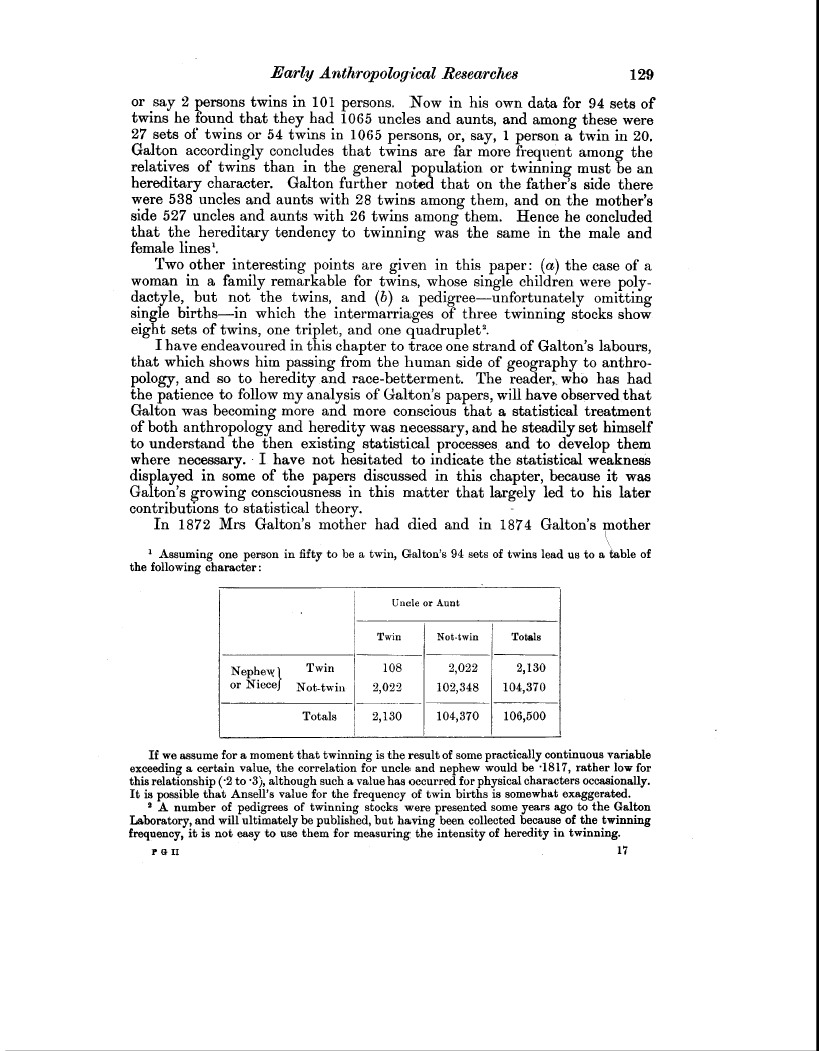Early Anthropological Researches 129 or say 2 persons twins in 101 persons. Now in his own data for 94 sets of twins he found that they had 1065 uncles and aunts, and among these were
27 sets of twins or 54 twins in 1065 persons, or, say, 1 person a twin in 20. Galton accordingly concludes that twins are far more frequent among the relatives of twins than in the general population or twinning must be an hereditary character. Galton further noted that on the father's side there were 538 uncles and aunts with 28 twins among them, and on the mother's side 527 uncles and aunts with 26 twins among them. Hence he concluded that the hereditary tendency to twinning was the same in the male and female lines'.
Two other interesting points are given in this paper: (a) the case of a woman in a family remarkable for twins, whose single children were polydactyle, but not the twins, and (b) a pedigree-unfortunately omitting single births-in which the intermarriages of three twinning stocks show eight sets of twins, one triplet, and one quadruplet'.
I have endeavoured in this chapter to trace one strand of Galton's labours, that which shows him passing from the human side of geography to anthropology, and so to heredity and race-betterment. The reader,, who has had the patience to follow my analysis of Galton's papers, will have observed that Galton was becoming more and more conscious that a statistical treatment of both anthropology and heredity was necessary, and he steadily set himself to understand the then existing statistical processes and to develop them where necessary. - I have not hesitated to indicate the statistical weakness displayed in some of the papers discussed in this chapter, because it was Galton's growing consciousness in this matter that largely led to his later contributions to statistical theory.
In 1872 Mrs Galton's mother had died and in 1874 Galton's mother i
' Assuming one person in fifty to be a twin, Galton's 94 sets of twins lead us to a table of the following character
| |
Uncle or Aunt |
| |
Twin |
Not-twin |
Totals |
|
Nephew Twin |
108 |
2,022 |
2,130 |
|
or Niece Not-twin |
2,022 |
102,348 |
104,370 |
|
Totals |
2,130 |
104,370 |
106,500 |
If we assume for a moment that twinning is the result of some practically continuous variable exceeding a certain value, the correlation for uncle and nephew would be -1817, rather low for this relationship (2 to -3), although such a value has occurred for physical characters occasionally. It is possible that Ansell's value for the frequency of twin births is somewhat exaggerated.
z A number of pedigrees of twinning stocks were presented some years ago to the Galton Laboratory, and will ultimately be published, but having been collected because of the twinning frequency, it is not easy to use them for measuring the intensity of heredity in twinning.
rail 17

